Research News
August 14, 2015
Utahns Voice their Ideas about Water
What’s the first thing that comes to mind when you think of water?
Scientists tend to think of issues as problems – water scarcity, declining water quality, and so on. But how do community members in Utah think about water? The Utah Water Voices Project, led by Dr. Courtney Flint with iFellows Zack Oldroyd and Andre Valle along with other USU students,* set out to open the water conversation with members of the public using social science research techniques.
The team selected six public spaces or parks along the Logan River to capture the iUTAH theme of a mountain to urban or valley gradient, and set out to conduct public intercept interviews at different times of day throughout the summer. Interview questions asked people about the values or benefits of water, as well as perceived threats or problems related to water in and beyond neighborhoods and communities. Flint’s students brought their interests in technology, setting up an interactive form on iPad tablets to guide paperless interviews and allow for quick collection of demographic data to help the survey team assess how well the their interviewees reflected the larger community. Interviews were audio recorded and lasted anywhere from 2 to 25 minutes (with an average of 7 minutes).
Interviewees spoke openly on a range of issues – from their thoughts on how important water is for their health and recreation to concerns about flooding, safety, pollution, and drought. Questions asked about interactions with different Utah water bodies and whether respondents would like to see their environmental condition changed – information that will be useful for the Utah Division of Water Quality as they try to incorporate local values and perspectives into their prioritization plans. iFellow Zack Oldroyd, who is studying Science Communication at Utah State, asked where people get their water information, revealing that a surprisingly high number of people don’t seek or receive any such information. iFellow Andre Valle, a Weber State Health Promotion major, sought to understand how well this research approach reaches a diverse cross-section of people and found that education, but not income or gender, is a very strong factor influencing whether people were willing to take part in interviews.
Over the course of the summer, Flint’s team of six completed 101 interviews in Logan and 33 in a 3-day effort in Salt Lake City. They created digital story videos by combining narration and photos with audio and transcript quotes from interviews. In the fall of 2015, they will work on creating an interactive web portal that will not only share the interviews with the wider public, but also invite more people from across Utah to share their water voices.
*USU Students Elizabeth Wynn, Charles Mascher, and Alex Brown contributed greatly to this research project by transcribing interviews, managing data, and helping to produce the multi-media videos to share water stories.


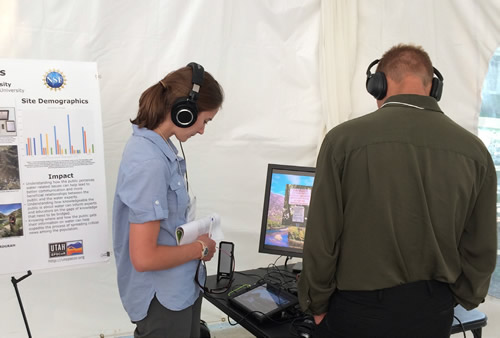
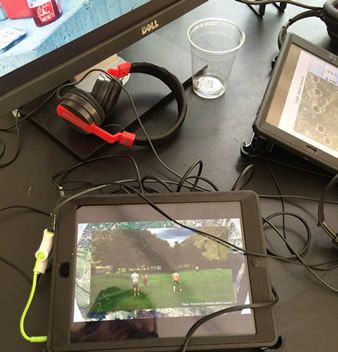
July 27, 2015
Insights into the urban water dynamics of Utah
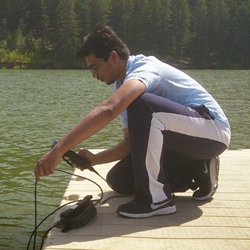 Public water supply systems are the life-blood of urban areas. How we use urban water systems affects more than human health and well-being. Our water use can alter a city’s energy balance, including how much solar energy is absorbed as heat or reflected back into space. It affects relationships among all living things within the city, and flows of water and natural chemicals through it. The severity of these effects, and the need to better understand connections between climate, water extraction, water use, and water use impacts, is strongest in dry climates and places undergoing substantial land-use change – for example, the rapidly urbanizing areas of Utah that are the focus of the iUTAH program.
Public water supply systems are the life-blood of urban areas. How we use urban water systems affects more than human health and well-being. Our water use can alter a city’s energy balance, including how much solar energy is absorbed as heat or reflected back into space. It affects relationships among all living things within the city, and flows of water and natural chemicals through it. The severity of these effects, and the need to better understand connections between climate, water extraction, water use, and water use impacts, is strongest in dry climates and places undergoing substantial land-use change – for example, the rapidly urbanizing areas of Utah that are the focus of the iUTAH program.
Studying the water’s “isotopic composition” – that is, the number and relative abundance of different isotope forms of common elements – can help us better understand these connections. University of Utah researcher Gabe Bowen and his PhD student, Yusuf Jameel, are studying how the isotopic composition of tap water in the Salt Lake Valley varies over space and time. With support from iUTAH, the group has gathered and analyzed stable water isotope data from a series of semi-annual hydrological surveys (spring and fall, 2013 and 2014) in urban tap water sampled across the Salt Lake Valley.
Their study has led to four major findings thus far: 1) Clear and substantial variation in tap water isotopic composition in space and time can be linked to different water sources and management practices within the urban area, 2) There is a strong correlation between the range of observed isotope values and the population of water districts, reflecting use of water from multiple local and non-local sources in districts with high water demand, 3) Water isotopes reflect significant and variable loss of water due to evaporation of surface water resources and 4) Overall, tap water contains lower concentrations of the heavy H and O isotopes than does rainfall within the basin, reflecting the connection between city water supplies and mountain water sources. The effect is increased as the climate grows drier and warmer.
Currently, Yusuf is writing a manuscript on his work and plans to submit it to a peer reviewed scientific journal. Gabe and Yusuf are also working with a major water supply company in the Salt Lake Valley to quantify the water loss during transmission and storage, the relative contribution from different sources of water, and transmission patterns of water in urban systems.
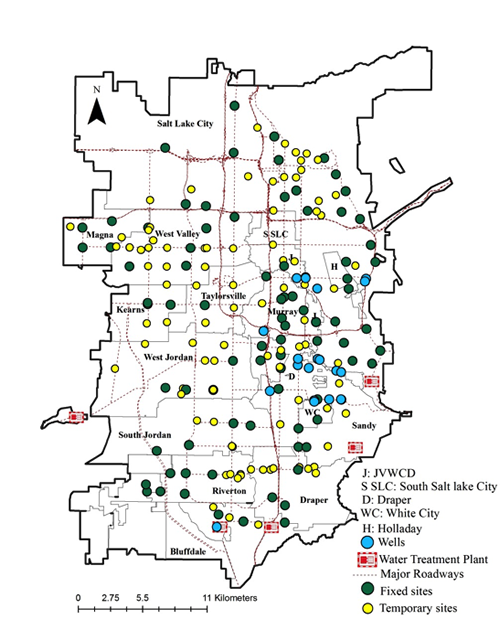

July 22, 2015
iUTAH Red Butte Creek Research
Nearly 50 researchers are converging on Red Butte Creek this week in a coordinated effort to understand the watershed like never before. The “synoptic sampling” event organized by iUTAH researcher and University of Utah hydrologist Paul Brooks brings together faculty and students from the University of Utah, Brigham Young University, Utah State University, Utah Valley University, Westminster College, and elsewhere to take a comprehensive “snapshot” of the water and surrounding land and air to better understand how to maintain a safe, stable water supply in the face of growing demand for water and a changing climate.

To learn more you can read, watch, and liste to what Salt Lake City-based news outlets have had to say about the event:
June 4, 2015
New Computer Software Helps Scientists See How Everything in Nature is Connected

Caleb Buahin, Utah State University, Research Assistant
Water touches everything. Farms, households, businesses, and nature all depend on water – and each of these also affects how water reaches the other entities that depend on it. As society makes greater demands on Utah’s water resources, scientists increasingly are asked to predict how the natural water cycle and our engineered water systems will respond to pressures such as population growth and climate change. What must Utah do to adapt to changes in snowfall or stream flows? How can we meet the needs of a population that could double in 40 years?
To make these predictions and begin to work toward solutions, scientists use mathematical “models” that account for the various factors that influence water flows and uses. These models – actually sophisticated computer programs – must be complex enough to describe how scientists believe that natural and built water systems behave, yet simplified enough that they can be useful to decision makers who must make choices with data that may be limited or incomplete. These data, called input variables, are processed in mathematical equations to predict the consequences for desired outputs, i.e., the products and services that society and nature need from water. For instance, a hydrologic model might take in data on rain and snowfall, air temperature, solar radiation, etc., as input variables to produce outputs such as river flows, evaporation, and plant uptake.

Figure 1: Simplified Representation of a Mathematical Mode
Scientists who study different domains of the water system develop unique models that can answer the questions that matter to them. For example, a hydrologist may want to predict how stream flows will decrease over the summer after the snow melts, while an industrial engineer might want to predict how a new technology can reduce the amount of water needed daily to cool an electrical plant. Their respective models both rely on information about water availability and desired outputs, but they probably won’t account for all of the factors that are part of the other’s model. To answer the larger questions about how Utah can respond to changes in water supply and demand, more holistic models are needed that cover multiple domains of the water system.
That’s the problem Caleb Buahin is working on. Caleb, a postdoctoral researcher with the iUTAH project at Utah State University, has developed a flexible software framework called HydroCouple (Figure 2) that allows scientists to bring together models from different domains and scientific disciplines. This approach, called component-based modeling, allows for the communication and exchange of information during calculations. It allows scientists to test and refine hypotheses about how water systems behave by experimenting with different models using the same framework.
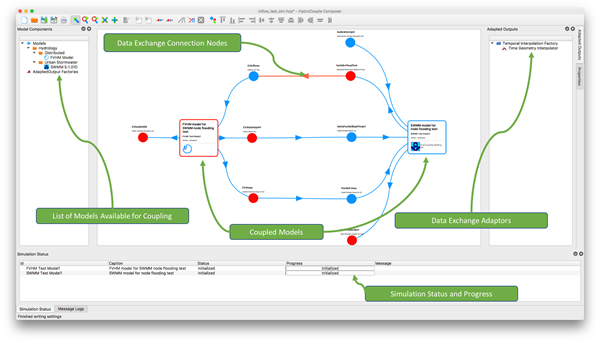
Figure 2: Software Framework Developed for Coupling Models
Caleb’s current work involves coupling together models that simulate the natural and built portions of urban water systems. By working with the City of Logan and using aquatic and climate data from iUTAH’s Gradients Along Mountain to Urban Transitions (GAMUT) network, he is able to examine present and future water capacity related to the cities’ stormwater system. An example output from his work shows the interactions between the canal system and the engineered stormwater infrastructure.
By demonstrating how this framework can be useful for bringing together models and data for different aspects of Utah’s water system, Caleb is creating software tools and guidance that can help other researchers evaluate not just water systems but other natural resource systems. In so doing, scientists will be able to avoid the pitfalls of studying parts of a problem independently, without considering the important ways that different resources affect each other and our future.
April 29, 2015
How Thirsty are the Trees we Plant in our own Front Yards?
Trees provide welcome shade and can reduce the need to water lawns in the hot Utah summer. But trees also need water themselves. Understanding how mature urban trees use water can help give municipal land and water managers a better idea of how to conserve water. Quantifying water use by the most common tree species may prove particularly valuable because forests do not naturally occur in Utah’s urban areas. Planted trees within the city are maintained by irrigation, requiring large amounts of water. iUTAH researcher Dr. Richard Gill and his graduate student, Michael Bunnell, are studying urban tree sites in the Heber Valley of Wasatch County, Utah. This valley is a rapidly developing landscape where populations are projected to grow 90% by 2030. With this urban expansion and human population growth, more trees are expected to be planted within the region, placing a greater demand on the valley’s water resources.
Bunnell’s initial findings show a trend in planting deciduous tree species such as maple in new developments within this region. These species inherently use more water than conifer species such as blue spruce. Looking at particular tree species, Bunnell’s initial findings suggest that the biggest determinant of water use for a single tree is the anatomy of the sapwood tissue. For example, some trees conduct water through all living tissue, while in others, water movement is constrained to the current year’s growth only.
In a region where water resources are limited, it is important to understand the influence of planted forests on water use. To achieve this goal Gill and his students are collecting sap-flux measurements to quantify daily and seasonal patterns of transpiration in dominant landscape trees occurring within suburban reaches of the Heber Valley. Ultimately, this research will assist urban land managers in better identifying water-efficient tree species and aid in making decisions about planting densities.

Fig 1: Sap flux sensors installed in an American sweetgum.
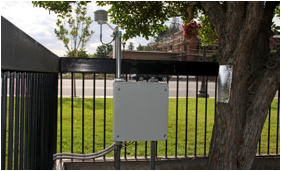
Fig 2. Enclosure for instrumentation collecting climactic data.
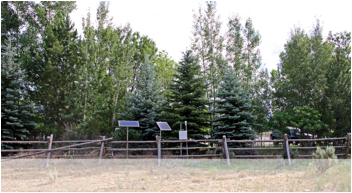
Fig 3. Sample of a field site location.
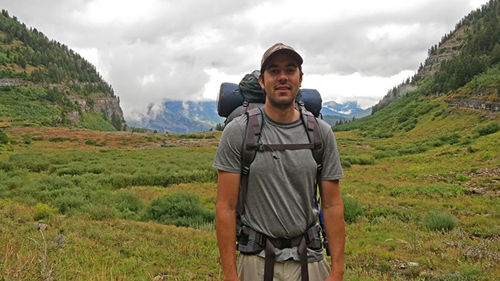
Micheal Bunnell


